Posted by Michael Pinto on Sep 28, 2006 in
Science A very good article on the issue of exposure to radiaion for astronauts wishing to explore Mars:
Future Mars astronauts have radiation on their minds
“Radiation encountered on extended trips to the Moon or Mars could harm astronauts’ brains, experiments on rats suggest. The space farers could face problems with spatial learning, memory and stress.
Astronauts aboard the space shuttle and the International Space Station are largely protected from space radiation by the Earth’s magnetic field. But the crew of a mission to Mars could spend three years outside this protective bubble. So NASA recently awarded funding for 12 projects that will investigate how long-term radiation exposure in interplanetary space could potentially cause health problems in astronauts.”

Posted by Michael Pinto on Sep 27, 2006 in
Science The source of the poll may have some bias on the subject, but I have to say that I also share that bias too:
New Gallup Poll Reveals Americans Continue to Strongly Support Space Exploration
“A new Gallup Poll shows more than two- thirds of respondents support the nation’s stepping-stone approach to space exploration, which includes flying the space shuttle to complete the International Space Station, building a replacement vehicle for the space shuttle, returning humans to the moon, and exploring Mars and points beyond. (Respondents support this approach if NASA’s budget does not exceed 1 percent of the federal budget.)
The most recent poll, conducted in August, is the last in a three-part series of polls commissioned by the Coalition for Space Exploration in an effort to better understand the extent of support and public attitudes toward America’s space program. The first polls were conducted in June of 2005 and March of 2006.”
Posted by Michael Pinto on Sep 26, 2006 in
Science Wow! This looks soooo friggin’ cool:
Space Explorer’s photos
flickr.com/photos/spaceexplorer/
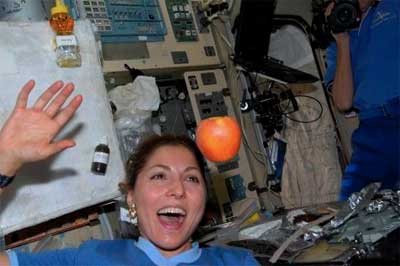
…Take a look at the upper left: it’s funny to know that they take those honey bears into orbit!
Posted by Michael Pinto on Sep 26, 2006 in
Science This is an interesting article from Wired News from the Space 2006 conference dealing with the issue of having human live in outer space long term:
Move Into Space, but Where?
“It’s not hard to sell attendees of the Space 2006 conference on permanent human settlements in space. Where those settlements should be, however, is another question. Various scientists make their case for Mars, the moon or habitats orbiting the Earth. While the question is not a pressing one for most people, for the futurists mapping the humans path to space, the destination makes all the difference in the world.
For Al Globus, senior research associate for human factors research and technology at NASA Ames Research Center, the most salient issue is one that most people take for granted on Earth: gravity. In low gravity, muscles atrophy and bones loose calcium and become brittle. If people start having children in an off-Earth settlement, those children — being adapted to the moon’s one-sixth gravity or Mars’ three-eighths gravity — may not be able to function on Earth, Globus argues.”
Posted by Michael Pinto on Sep 23, 2006 in
Science This is quite creepy – or -cool – it seems a company in Japan has created an articial skin for robots:
Robot beauty goes skin-deep
“In a move that could provide a crucial boost to our robotic friends struggling up the near side of the Uncanny Valley, major cosmetics manufacturer Kao Corporation and a Keio University research team led by robotics professor Takashi Maeno have developed an artificial skin that feels just like human skin.
Skin, the largest organ of the human body, consists of a soft layer of tissue (dermis) covered by a tougher protective layer (epidermis). The artificial skin developed by Kao and Keio mimics the feel of human skin with a 1-cm thick “dermis” of elastic silicone covered by a 0.2-mm thick “epidermis” of firm urethane. Countless tiny hexagonal indentations etched into the urethane epidermis provide it with a very realistic texture.”
…what cool to me about this isn’t so much the idea of robots that look like people, but that this invention might be put to good use on artificial limb technology.

Posted by Michael Pinto on Sep 22, 2006 in
Science It’s amazing how much we still don’t know about our solar system:
New ring discovered around Saturn
“The Cassini spacecraft has identified a faint, previously unknown ring circling the giant planet Saturn. It appears to be composed of material blasted off the surface of two saturnian moons by meteoroid impacts. The moons Janus and Epimetheus may be too small to hold on to dust kicked out by these impacts, so it escapes into space, spreading out into a ring. The tenuous, wispy ring coincides with the orbits of these two moons, mission scientists noted.”
Posted by Michael Pinto on Sep 18, 2006 in
Science From what I’ve been reading she’s a Star Trek fan! I’m green with envy:
Female space tourist blasts off
“A Russian-built rocket carrying the world’s first female space tourist lifted off Monday in Kazakhstan on a flight to the international space station. Anousheh Ansari, an Iranian-American telecommunications entrepreneur, was accompanied by a U.S.-Russian crew on the Soyuz TMA-9 capsule. Ansari is aiming to realize a life-long dream. As the fourth space tourist, the Iranian-born American also becomes the first woman to pay her way into space, and the first person of Iranian descent to get there.”
Posted by Michael Pinto on Sep 15, 2006 in
Science Pluto’s twin has a new name, and sadly Xena fanboys (and fangurls) will be a bit let down:
A Dwarf Planet Gets a Name: Eris
“The dwarf planet formerly known as Xena received a new name today, while Pluto was given a number to reflect the loss of its status as a planet. Dr. Michael E. Brown, a professor of planetary astronomy at the California Institute of Technology who discovered the distant ball of ice and rock that he nicknamed Xena, chose the name Eris, after the goddess of discord and strife in Greek mythology. The International Astronomical Union made the name official today.”
…but it’s even worse, Pluto now has been given a number! It’s like the sad dwarf planet is a common criminal:
“Pluto, now that it is no longer a planet, has been assigned the number 134340 in the catalog of minor planets. In 1999, the astronomical union’s Minor Planet Center had proposed assigning Pluto the number 10000 in the same catalog, to give it dual citizenship as both a planet and a member of the Kuiper Belt, a ring of icy debris beyond Neptune. Brian Marsden, director of the center, said it was meant as special recognition for Pluto, but the idea was withdrawn after protests from people who saw it as a demotion.”
Keck Telescope image of Eris and its moon Dysnomia:

Posted by Michael Pinto on Sep 14, 2006 in
Science The photo below is what Saturn looks like at night. In contrast to the human-made lights that cause the nighttime side of Earth to glow faintly, Saturn’s faint nighttime glow is primarily caused by sunlight reflecting off of its own majestic rings. The above image of Saturn at night was captured in July by the Cassini spacecraft now orbiting Saturn. The thumbnail doesn’t do the photo any justice (you need to see all of the cool detail to appreciate the image), so you should click to the link and see the photo full scale:
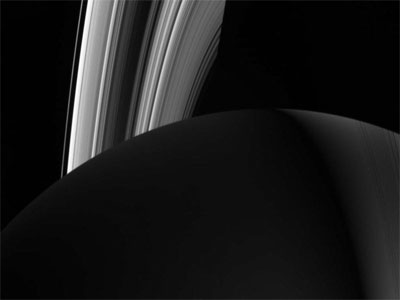
antwrp.gsfc.nasa.gov/apod/ap060912.html
Posted by Michael Pinto on Sep 13, 2006 in
Science Maybe all of those old episodes of Star Trek were right? It looks like there may be a few more planets like Earth out there:
Earth-like Planets May Be More Common Than Once Thought
“More than one-third of the giant planet systems recently detected outside Earth’s solar system may harbor Earth-like planets, many covered in deep oceans with potential for life, according to a new study led by the University of Colorado at Boulder and Pennsylvania State University.
The study focuses on a type of planetary system unlike our solar system that contains gas giants known as “Hot Jupiters” orbiting extremely close to their parent stars — even closer than Mercury to our sun, said CU-Boulder researcher Sean Raymond. Such gas giants are believed to have migrated inward toward their parent stars as the planetary systems were forming, disrupting the space environment and triggering the formation of ocean-covered, Earth-like planets in a “habitable zone” conducive to the evolution of life, according to the new study.”
Posted by Michael Pinto on Sep 12, 2006 in
Science Well it’s not exactly Mars, but as close as we can get to it on Earth:
Sign Up for a Mission to ‘Mars’
“Next summer, six scientists will get to travel to the desolate permafrost desert of the Arctic, live in a two-level metal can and only go outside wearing 40 pounds of faux spacesuit. Not your idea of fun? For the scientists, it could be. The team will be the first to get a taste of what it will be like to live on Mars for months at a time, and they get to skip the half-year trip to the red planet to boot.
The research station is run by the Mars Society, a group of scientists, engineers and futurists intent on accumulating the knowledge needed for manned exploration of Mars. The goal of the four-month tour is to develop field research techniques applicable for scientific investigations of the planet, said Robert Zubrin, an aeronautical engineer and president of the society.”
Posted by Michael Pinto on Sep 10, 2006 in
Science Here’s some wall decor for geeks:
The Most Beautiful Periodic Table Poster in the World
“After four years of collecting and photographing samples of all the chemical elements, months of struggling to select the very best example of each one, and further months of working on the best possible printing quality, I am pleased to say that you can now buy a copy of my photographic periodic table poster. The images come from my library of over a thousand element samples, many collected or re-photographed specially for this poster. (A few highly unstable elements show a picture of the person or place after which the element is named, or a mineral that contains trace amounts of the element.)”
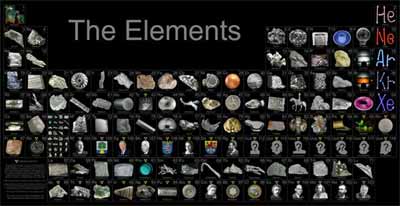
…the above thumbnail image doesn’t do the poster justice, you need to see the images upclose!
Posted by Michael Pinto on Sep 10, 2006 in
Science To encourage folks to do space elevator research, several groups are funding a competition for people to build build the the strongest tether and the fastest moving vertical robot:
Space Elevator Games to Spur a New Generation of Space Travel
“The Spaceward Foundation recently announced the second annual Space Elevator Games to be held in partnership with NASA and the X PRIZE Foundation at the Las Cruces International Airport in New Mexico, USA. Together, NASA, Spaceward, and X PRIZE are looking to jumpstart safe and efficient space exploration using prizes for private research; much like the Orteig Prize which was won by none other than Charles Lindbergh in his Spirit of St. Louis. The competitions have a total purse of $400,000 sponsored by NASA’s Centennial Challenges program, quadrupling the amount of prize money of last year’s event. Two prizes will be awarded to teams who can build the strongest tether, and the fastest moving vertical robot. Over twenty teams from different universities and research groups will be competing for a piece of space travel history.
Read more…
Posted by Michael Pinto on Sep 9, 2006 in
Science It looks like astronomers are starting to think that there may be more Earth like planets that are out there, of course this isn’t anything new as Carl Sagan was talking about this sort of thing over twenty years ago. But what is new is that we are starting to get a real glimpse at other solar systems, it’s too bad folks like Carl Sagan and Isaac Asimov aren’t alive to see the revolution that is starting in astronomy:
Study: Earthlike planets may be common
“Earthlike planets covered with deep oceans that could harbor life may be found in as many as a third of solar systems discovered outside of our own, U.S. researchers said on Thursday. These solar systems feature gas giants known as “Hot Jupiters,” which orbit extremely close to their parent stars — even closer than Mercury to our sun, University of Colorado researcher Sean Raymond said.
The close-orbiting gassy planets may help encourage the formations of smaller, rocky, Earthlike planets, they reported in the journal Science. “We now think there is a new class of ocean-covered, and possibly habitable, planets in solar systems unlike our own,” Raymond said in a statement.
The team from Colorado, Penn State University and NASA’s Goddard Space Flight Center Maryland ran computer simulations of various types of solar systems forming. The gas giants may help rocky planets form close to the suns, and may help pull in icy bodies that deliver water to the young planets, they found.”
Posted by Michael Pinto on Sep 1, 2006 in
Science It’s great news to see that NASA might get back to the moon, not quite as cool as going to Mars but I’ll gladly settle to see some real manned space exploration in the next few years. I grew up on Long Island so i would have liked to see Northrop Grumman get the project, but maybe just maybe this is the start of a new day for NASA:
Lockheed Martin to build future moonship
Team chosen over Northrop Grumman, Boeing for $3.9 billion Orion project
“Lockheed Martin on Thursday won NASA’s multibillion-dollar nod to build the Orion crew exploration vehicle, a spaceship with a look and a mission that echoes the space agency’s giant leap to the moon in the 1960s.
The announcement kicks off an effort to produce spacecraft that would replace NASA’s fleet of space shuttles, due for retirement in 2010. NASA’s timetable calls for the cone-shaped Orion ships to bring cargo or up to six crew members to the international space station by 2014, and carry up to four astronauts to the moon and back by 2020.
For 13 months, two high-profile aerospace teams — one led by Lockheed Martin, the other led by Northrop Grumman and The Boeing Co. — have worked on paper proposals to fit NASA’s specifications. Now it’s up to Lockheed Martin to turn the concept into a reality.”
Here’s some cool concept art of the project:
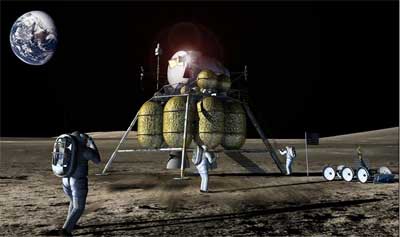
Posted by Michael Pinto on Aug 19, 2006 in
Science This finding reminds me a great deal of the movie Blade Runner:
Clone ‘would feel individuality’
http://news.bbc.co.uk/1/hi/health/5187990.stm
A cloned human would probably consider themselves to be an individual, a study suggests. Scientists drew their conclusions after interviewing identical twins about their experiences of sharing exactly the same genes with somebody else. The team said the twins believed their genes played a limited role in shaping their identity.
Posted by Michael Pinto on Aug 13, 2006 in
Science Fan of the Six Million Dollar Man will remember Steve’s bionic eyes, well it looks like that technology will remain science fiction for a while yet (but it’s neat to know they are working on this stuff):
FDA Says No to Bionic Eye
livescience.com/humanbiology/ap_060715_bionic_eye.html
A U.S. company had hoped that next year that might be your grandmother. Not so fast, a federal advisory panel said Friday. A tiny telescope designed to be implanted in the eyes of some elderly patients should not receive Food and Drug Administration approval, the panel recommended on a 10-3 vote. The FDA’s ophthalmic devices panel recommended against the pea-sized bionic device for safety reasons, spokeswoman Heidi Valetkevitch said.
The first-of-its-kind device is called the Implantable Miniature Telescope. The telephoto lens could enable some patients to do away with the special glasses and handheld telescopes they now use to compensate for the loss in central vision caused by age-related macular degeneration, according to VisionCare Ophthalmic Technologies Inc., its manufacturer.
Related links:
VisionCare Ophthalmic Technologies Inc.
Posted by Michael Pinto on Aug 11, 2006 in
Science This concept seems so far fetched to me – not the idea of a moonbase itself, but planning one over twenty years in advance:
Japanese to Live on the Moon
“It takes something fairly outlandish to raise eyebrows in today’s scientific and technological communities, but the Japan Aeorspace Exploration Agency (JAXA) did just that at an international conference held in Tokyo last week. The agency announced its goal to build an inhabitable base on the moon by 2030. Preceding the construction of the lunar base, JAXA has some work to do. Junichiro Kawaguchi, the Japanese agency’s director, said the current plan is to send astronauts to the moon in 2020 to begin construction. In the immediate future, the Japanese space program plans to send a new satellite into orbit and unmanned, robot-run missions to the moon to collect rock samples from the moon’s surface as early as next year.”
An artist’s rendering of JAXA’s future manned flight to the moon:
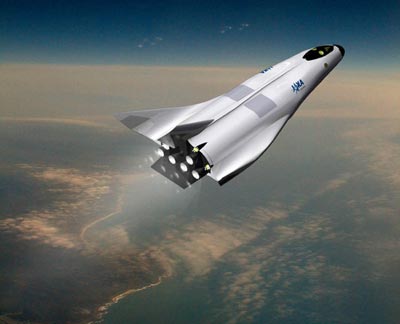
Posted by Michael Pinto on Aug 10, 2006 in
Science This sounds quite cool, but I think if I was paying $200k I’d like to spend a bit more than 5 minutes in outerspace:
Space travel will take off in five years, travel boss says
“Commercial flights to space could be taking off from Britain within five years, the head of the space travel firm Virgin Galactic said Wednesday. Will Whitehorn said the Lossiemouth Royal Air Force base in Moray, in Scotland, is on track to be used as a base for the company’s spacecraft from 2011. Virgin Galactic, owned by billionaire British entrepreneur Richard Branson, will charge 110,000 pounds (209,600 dollars, 162,900 euros) a ticket to give passengers to experience weightlessness for five minutes. It plans to operate around seven spacecraft that will fly 87 miles (156 kilometres) above the earth’s surface.”
Posted by Michael Pinto on Aug 1, 2006 in
Science What’s cool about this is that so far we’ve only discovered about 200 planets outside our solar system, so my guess is the number of discoveries will only continue to grow over the next century – and maybe just one of those planets will be like Earth:
Habitable Planet Possible Around Nearby Star System
http://www.space.com/scienceastronomy/060801_science_tuesday.html
In recent years, with improving technology, researchers have found a handful of systems that could harbor life-bearing planets, in theory at least. A nearby star called 55 Cancri is one of the leading candidates.
The 55 Cancri system involves three gas giant planets and another world that could be icy or rocky and is about the size of Neptune. The setup is 41 light-years from Earth and about 4.7 billion years old, comparable to our Sun.
Astronomers have said since 2002, when a planet was found at about the same orbital distance from 55 Cancri as Jupiter is from the Sun, that the star had the potential to harbor an Earth-sized world.
Posted by Michael Pinto on Jul 31, 2006 in
Science This looks like bad news for the space tourism industry:
Outer-space sex carries complications
Experts say new devices and data would be needed to hit the zero-G-spot
http://www.msnbc.msn.com/id/14002908
Having sex in the weightlessness of outer space is the stuff of urban legends and romantic fantasy — but experts say that there would be definite downsides as well. Spacesickness, for instance. And the difficulty of choreographing intimacy. And the potential for sweat and other bodily fluids to, um, get in the way.
“The fantasy might be vastly superior to the reality,” NASA physician Jim Logan said here Sunday at the Space Frontier Foundation’s NewSpace 2006 conference. Nevertheless, Logan and others say the study of sex and other biological basics in outer space will be crucial to humanity’s long-term push into the final frontier.
…by the way there’s been a book and website published on topic:
Sex in Space by Laura Woodmansee






















